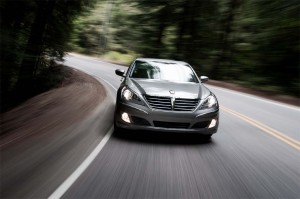It was a great first quarter for Hyundai, the upstart Korean carmaker that has been much of the auto industry’s established order a scare. The maker reports it earned $1.75 billion for the January to March period, a 46% jump.
With demand up everywhere from Berlin to Beijing – and Boston in- between — Hyundai also recorded global sales of 922,000 for the quarter pushing it in front of Japan’s number three maker, Honda. Considering the huge losses in production Honda and the rest of the Japanese have suffered in the wake of that nation’s March 11 disaster, Hyundai is likely to maintain that lead, analysts suggest, for at least another quarter, if not longer.
Hyundai’s net, 1.88 trillion in Korean won, was up from 1.28 trillion won a year ago. First-quarter sales and revenues totaled 18.23 trillion won, a 21% increase.
The Korean company has been on an aggressive growth curve fueled by the expansion of its line-up into a variety of new segments, and from the addition of overseas assembly plants, such as the facility it opened in Alabama, two years ago.
At the New York Auto Show, this month, the maker is giving motorists a preview of its upcoming Accent redesign, the subcompact set to become the fourth Hyundai product offered in the U.S. delivering a minimum 40 mpg Highway. But the maker has also launched the all-new Equus, its first attempt at targeting the premium-luxury segment dominated by makers like BMW, with the 7-Series, and Mercedes-Benz, with the S-Class. A new version of the mid-luxury Hyundai Genesis will be previewed later this year.
Notably, Hyundai’s home market sales were relatively flat for the quarter, but demand jumped 14% abroad. The output of the U.S. factory was up 23% year-over-year, while production at Hyundai’s Chinese plants climbed 13%.
Hyundai is also reporting higher transaction prices, reflecting not the move to premium segments but the willingness of buyers to pay more for even the older, entry-level models the Koreans were first known for.
The carmaker has been unabashedly aggressive in taking advantage of its Japanese rivals’ problems, last year pointedly aiming to conquest Toyota owners worried about that maker’s quality and safety problems.
Toyota says it lost about 300,000 units of production from its Japanese plants alone, in March, and warns it may not get production back to normal until late this year. Honda, meanwhile, has also suffered significant losses, which are expected to continue — causing problems with the upcoming launch of the new Civic mode.
While U.S. CEO John Krafcik said the maker wouldn’t openly play up the latest Japanese disaster, he told TheDetroitBureau.com, last week, that the situation does present an “opportunity” for Hyundai to win over customers who might not want to wait if the Japanese product shortages worsen.
“Chaos brings disorder and that’s the time you see changes in ranks among leaders,” analyst Lim Jeong Seok, at KDB Asset, told Business Week. “The past financial crisis and the recent earthquake may be an opportunity for Hyundai to pass bigger rivals.”

